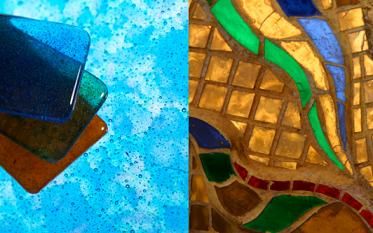
"Pressed glass was fine crystal to the middle-class folks." I say this for a reason, and the reason is that glassware was an expensive baggage to buy in the archaic times. Fine crystal could not be afforded by the masses. Sipping wine from a crystal goblet was a privilege availed only by a special 'selected' few. This is where pressed glass came to the forefront. John P. Bakewell is credited for the invention of pressed glass in the year 1825. It was inexpensive and meant for the masses. It was a type of glass that was made by using a technique, where the molten glass was made to dive into a plunger to convert it into a shapely mold. The plunger was used as the tool to produce pressed glass patterns.
The Evolution of Pressed Glass
When pressed glass was invented in the year 1825, they were referred to as lacy glass. The designs of this type of glass were produced by employing a technique called stippling. This technique involved decorating the glass with dots on the interiors of the glassware, giving it a rich look. Stippling technique encouraged the production of many objects such as candlesticks, goblets, fancy plates, ornate water jugs and lots more. Later, during the mid 19th century, the formerly called lacy glass adorned a new term for itself and that was pattern glass. Stippling as a technique, gave way to colored glass patterns. The colors introduced were attention seekers in their own way. Blue and green were the colors of the 'royal' class. Nature designs became the backbone of pressed glass pattern decorations. Borders were also introduced to make the glassware look more interesting. The late 19th century saw the onset of opal or opaque glass. Collectors now call it by the name of milk glass. Milk glass got its milky color through the addition of bone ash. The latest to join the list is named the vaseline glass.
Initiation of Pressed Glass Patterns
The induction of discovering and producing different patterns was a humble one. Designs that had nature as its background became the backbone of such glass patterns. As time elapsed, pressed glass patterns were not just confined to different color usage or natural backgrounds and borders. It spread its wings far and wide by adapting to the cut glass patterns. Patterns such as Ashburton (named after Alexander Baring 'Lord Ashburton' of Great Britain.), Diamond Thumb-print and Bellflower were the classic cut glass designs imitated by glass-men for producing pressed glass. They were found on kitchen cutlery such as goblets, plates, jugs, food bowls, spoons, knife rests to make the pieces look attractive.
How to Identify Pressed Glass
Pressed glass pattern identification can be a task if you don't know what a pattern looks like. One could comment that pressed glass falls in close relation to cut glass. Pressed glass can be identified by its edges being round and smooth. It ranks lower in terms of index of refraction. One can also find mold marks on the glass whereas cut glass is free of mold marks. You could identify pressed glass when you tap it on another object. The sound it emits is dull and thick. To identify pressed glass patterns one could also refer to the collectors guide for more information. In your quest to identify different patterns, you could take help from other collectors as well. You could compare your collection with theirs and observe how the designs differ from one another. Owning an antique collection is an honor in its own respect, for a collector. Ashburton, Diamond Thumbprint and Bellflower are patterns that the collector must possess. These patterns are priced very high in today's day and age.
Different patterns of pressed glass are a collectors prized possessions. They exude charm with extravagant light. So, forge ahead, and build a collection for keeps!





